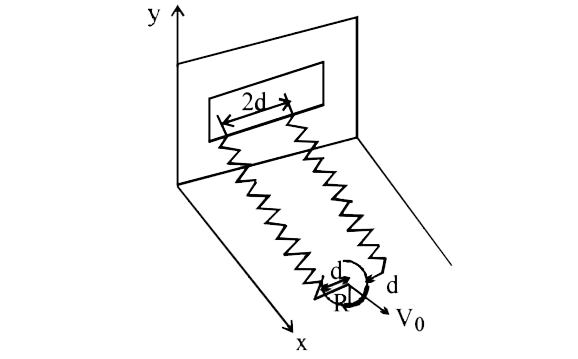An α- particle and a proton are accelerated from rest by a potential difference of 100V After this their de Broglie wavelength are λαandλp respectively The ratio λpλα , to the nearest integer is Solution in Gujrati
The correct Answer is:3
hλ=p=√2mqV
⇒λPλα=√mαqαmPqP=√4×2=√8≈3
Topper's Solved these Questions
- SIMPLE HARMONIC MOTIONBOOK - ALLEN CHAPTER - SIMPLE HARMONIC MOTIONEXERCISE - Solved Example
3 Videos
- SIMPLE HARMONIC MOTIONBOOK - ALLEN CHAPTER - SIMPLE HARMONIC MOTIONEXERCISE - X Rays : Solved Example
2 Videos
- SIMPLE HARMONIC MOTIONBOOK - ALLEN CHAPTER - SIMPLE HARMONIC MOTIONEXERCISE - Paragraph
3 Videos
- RACEBOOK - ALLEN CHAPTER - RACEEXERCISE - Basic Maths (Wave Motion & Dopplers Effect) (Stationary waves & doppler effect, beats)
25 Videos
- TEST PAPERBOOK - ALLEN CHAPTER - TEST PAPEREXERCISE - PHYSICS
4 Videos
Similar Questions
A hydrogen like atom with atomic number Z is in an excited state of quantum number 2n. It can emit a maximum energy photon of 204 eV. If it makes a transition ot quantum state n, a photon of energy 40.8 eV is emitted. Find n, Z and the ground state energy (in eV) of this atom. Also calculate the minimum energy (in eV) that can be emitted by this atom during de-excitation. Ground state energy of hydrogen atom is – 13. 6 eV.
View SolutionWhen X-rays if wavelength 0.5Å pass through 10mm thick Al sheet than their intensity is reduced to one sixth . Find the absorption coefficient for Aluminium.
View SolutionA uniform thin cylindrical disk of mass M and radius R is attaached to two identical massless springs of spring constatn k which are fixed to the wall as shown in the figure. The springs are attached to the axle of the disk symmetrically on either side at a distance d from its centre. The axle is massless and both the springs and the axle are in horizontal plane. the unstretched length of each spring is L. The disk is initially at its equilibrium position with its centre of mass (CM) at a distance L from the wall. The disk rolls without slipping with velocity →V0=vacV0ˆi. The coefficinet of friction is μ.

The net external force acting on the disk when its centre of mass is at displacement x with respect to its equilibrium position is.
View SolutionThe frequency of a radar is 780 MHz. After getting reflected from an approaching aeroplane, the apparent frequency is more than the actual frequency by 2.6 kHz. The aeroplane has a speed of
View SolutionChoose the correct statement:
View SolutionAn a- particle and a proton are accelerated from rest by a potential difference of 100 V After this their de Broglie wavelength are lambda_(a) and lambda_(p) respectively The ratio (lambda_(p))/ lambda_(p)) , to the rearest integer is
View SolutionA proton and an α-particle are accelerated, using the same potential difference. How are the de-Broglie wavelengths λpandλa related to each other?
View Solutionlambda_(e),lambda_(p) and lambda_(alpha) are the de-Broglie wavelength of electron, proton and alpha particle. If all the accelerated by same potential, then
View SolutionThe de-Broglie wavelength of an electron, an α -particle and a proton are λe,λα,λp. Which is wrong from the following:
View SolutionThe de-Broglie wavelength of an electron, an α-particle and a proton are λe,λa,λp. Which is wrong from the following?
View SolutionIf alpha particle, proton and electron move with the same momentum, then their respective de Broglie wavelengths lambda_(alpha), lambda_(p), lambda_(e ) are related as
View Solutionएक ऐल्फा - कण और एक प्रोटोन , विराम स्थिति 100 V से के विभवांतर द्वारा त्वरित किये जाते है। इसके बाद उनके दे ब्रोग्ली तरंगदैर्घ्य क्रमशः λαऔरλp है। अनुपात λp/λα का निकटतम पूर्णांक ………. है।
View Solutionयदि अल्फा कण, प्रोटोन और इलेक्ट्रॉन एक समान संवेग से गतिज हो, तब उनकी डी-ब्रोग्ली तरंग दैर्ध्य λα,λp,λe आपस में संबद्धित होंगे
View Solutionइलेक्ट्रॉन, प्रोटॉन तथा α-कण की डी-ब्रोग्ली तरंगदैर्ध्य क्रमशः λe,λpऔरλα है । यदि सभी V विभव पर त्वरित किया जाए, तब
View SolutionA proton and an alpha =particle are accelerated using the same potential difference.How are the de-Broglie wavelengths lambda_(p) and lambda_(a) related to each other?
View SolutionA proton and an α-particle are accelerated, using the same potential difference. How are the de-Broglie wavelengths λpandλa related to each other?
View Solution
